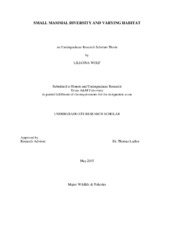| dc.creator | Wolf, Lilianna Krisko | |
| dc.date.accessioned | 2015-06-30T14:03:05Z | |
| dc.date.available | 2015-06-30T14:03:05Z | |
| dc.date.created | 2015-05 | |
| dc.date.issued | 2014-10-01 | |
| dc.date.submitted | May 2015 | |
| dc.identifier.uri | https://hdl.handle.net/1969.1/154541 | |
| dc.description.abstract | Few studies have been conducted related to mammalian diversity in the transitional montane
cloud forest region of Costa Rica. It is critical that the void in available data be filled in order to
support future research efforts. In the summer of 2014 I completed data collection for a population abundance analysis of small and medium mammals in four different habitat zones of the montane cloud forest. The purpose of this research is to determine what differences exist in species richness and population density between residential, tree plantation, secondary forest, and primary forest habitats in the area. The four habitats represent different stages of human development on forested land, with primary forest being historically un-degraded habitat, secondary forest being formerly degraded habitat, plantation representing an agroforested crop land, and residential being a completely human-controlled degraded habitat. | en |
| dc.format.mimetype | application/pdf | |
| dc.subject | Small Mammal | en |
| dc.subject | Costa Rica | en |
| dc.subject | montane cloud forest | en |
| dc.subject | agroforestry | en |
| dc.title | Small Mammal Diversity and Varying Habitat | en |
| dc.type | Thesis | en |
| thesis.degree.department | Wildlife and Fisheries Sciences | en |
| thesis.degree.discipline | Wildlife & Fisheries Sci. | en |
| thesis.degree.grantor | Honors and Undergraduate Research | en |
| dc.contributor.committeeMember | Lacher, Thomas | |
| dc.type.material | text | en |
| dc.date.updated | 2015-06-30T14:03:05Z | |


